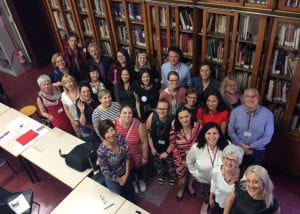….go and see a lot of libraries and books (but a lot of Rome too)
I recently attended an Erasmus Staff Mobility Libraries week, hosted by Sapienza University in Rome.
Erasmus+ enables UK higher education students, recent graduates and staff to study, gain work experience, teach or train abroad. Funding is used to bring international academics, industry experts and other professionals to your institution.
Sapienza University is an established partner to the University of Lincoln. With over 700 years of history, La Sapienza is Europe’s largest university with ca. 112,000 students and over 8,000 employees, including professors, staff and technicians.
The scientific research activity at Sapienza covers an extremely wide spectrum of disciplines, including archaeology, physics and astrophysics, the humanities and cultural heritage, the environment, nanotechnologies, cell and gene therapy, design, aerospace, social and economic sciences.
La Sapienza is organized into 11 faculties, a school of advanced studies, a post-graduate school of aerospace engineering, 59 departments, as well as numerous research and service centres.
There are also many faculty libraries at La Sapienza. In addition, the digital library organizes and makes many cultural and scientific heritage documentation available to the international community.
Sapienza Library System held its second Erasmus Staff Week entitled ‘Being an Academic Library’ (May 20-23, 2019) for librarians and information professionals.
The Erasmus Staff Week focused on:
- Academic library’s mission and strategic plan
- Innovative services
- Successful experiences in re-organising traditional services or creating new ones
- Emerging needs
- Third mission goals and library activity
- Supporting tools
The final programme was based on the topics raised by participants’ abstracts. All the sessions were chaired by Sapienza staff and host speakers coming from the same institution. Each day we attended different Sapienza facilities in Rome, both in main campus and off-campus.
On Sunday 19th May I was extremely nervous travelling on my own abroad to somewhere I had never been before. I was also very excited and enthusiastic about it so I was determined to make sure I got there ok. I made it to Rome on the Sunday and was ready to begin my Erasmus week.
The University city of La Sapienza in Rome was built following Mussolini’s orders, between 1932 and 1935, under the direction of architect Marcello Piacentini. There is a good blog, Veni, Vidi, Visit about the architecture of the University.
Monday 20th May
We were based at Sala organi collegiali (Rectorate building) which was designed by Marcello Piacentini himself. It is the first building you see as you enter from the front main entrance and the statue of Minerva sits in front.
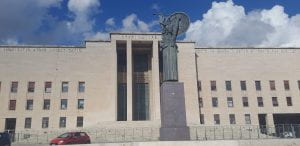
The room we were in had a PC and microphone with each desk so that we can see the presentations on the screen. I had already met up that morning with the other UK participant who was from York St John University. We received a warm welcome from the organiser, Agnese Galaffi and her colleagues and had a series of presentations from Sapienza staff and from some of the participants. These ‘self-presentations’ were to give a snapshot of the variety of home institutions and libraries but not everyone was able to present due to time over running. Delegates were from Portugal, Finland, Sweden, France, Poland, Slovenia, Belgium, Spain, Greece, Lithuania, Hungary and the Netherlands.
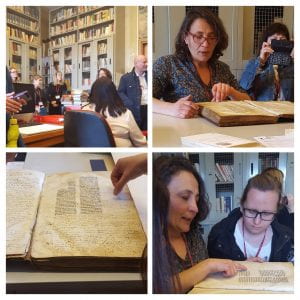
We also had a tour of the campus and the Library facilities. The print books in this building are in many different rooms and locked away. It is not easy for students to browse and they would need to ask to see a book. There are some lovely study areas however, in bright rooms and in inspiring spaces including in the Sapienza museum complex, which houses a lot of classical art and more contemporary exhibitions.
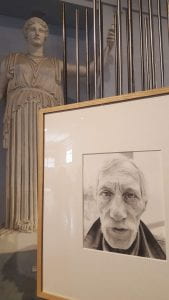
We spent some time in the Aula Magna del Rettorato della Sapienza which is a theatre and concert space with a huge 1935 fascist-era, mural by Mario Sironi as a backdrop to the stage.
The mural is entitled “L’Italia fra le Arti e le Scienze”–Italy between the Arts and Sciences. In 1933, Mussolini received the artist and Sironi took the commission for the mural and, in two months, painted representations of astronomy, mineralogy, botany, geography, architecture, literature, painting, and history–the latter symbolized by the woman, at front/right, back turned, a book in her hands. When it was unveiled, along with the rest of the university, in 1935 or 1936, it included prominent Fascist symbols including a triumphal arch – the symbol of Roman conquests, a Fascist eagle, the Fascist date XIV (14th year of Fascism, or 1936), and a figure, thought to be Mussolini, on horseback.
Immediately after the war it was covered with paper and then in the 1950s Carlo Siviero was charged with a ‘censorship’ of the mural and to eliminate the fascist symbols. It was unfortunate that someone had censored the bottom corner of the mural for our visit!
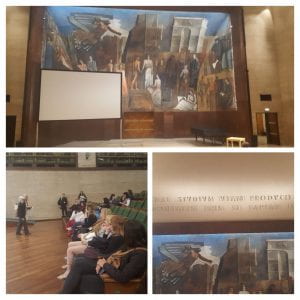
Other buildings of interest included the School of Mathematics building by Ponti. Giovanni “Gio” Ponti was an Italian architect. During his career, which spanned six decades, Ponti built more than a hundred buildings in Italy and in the rest of the world. Ponti’s Faculty of Mathematics building on the university campus in Rome (under the direction of Piacentini) was completed in 1935.
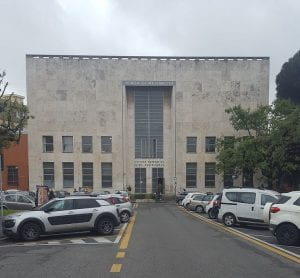
On the Monday evening, I managed to visit the Trevi Fountain and the Spanish Steps. I finished my evening with a fantastic gluten free pizza and a glass of wine at a restaurant nearby.
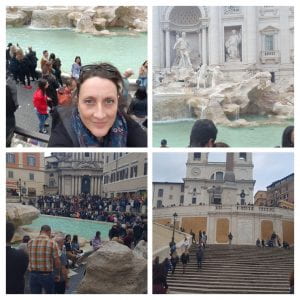
The Trevi Fountain (Italian: Fontana di Trevi) is a fountain in the Trevi district in Rome, designed by Italian architect Nicola Salvi and completed by Giuseppe Pannini and several others. It is the largest Baroque fountain in the city and one of the most famous fountains in the world.
I climbed the 174 Spanish Steps built with French diplomat Étienne Gueffier’s bequeathed funds of 20,000 scudi, around 1723 linking the Bourbon Spanish Embassy, and the Trinità dei Monti church that was under the patronage of the Bourbon kings of France, both located above — to the Holy See in Palazzo Monaldeschi located below. The steps were designed by architects Francesco de Sanctis and Alessandro Specchi.
Tuesday 21 May
The day started with everyone meeting at the Minerva statue at the main Rectorate building. We then walked through the district of San Lorenzo, which, due to the vicinity of the La Sapienza University, is increasingly popular with students and artists. Here you can find pizzerias, bookshops and cafes. Our destination was the Oriental Studies Library (Marco Polo compound). The Italian Institute of Oriental Studies is in an amazing converted former postal sorting centre building.
The complex houses classrooms and laboratories and houses two libraries with around 340 thousand volumes in an area of approximately 2,000 square meters, with a reading room that is open 24 hours a day. There are many study spaces for students, and events are frequently held in the Libraries including classical concerts and piano recitals using their own grand piano.
We started the session with an ‘International breakfast’ and all the delegates brought an item of food from their country to sample. I was limited to gluten-free Belgian chocolates and a bit of cheese! My contribution of a tin of baked beans was heated up but didn’t get much attention.
The delegate presentations of the day were on the theme of ‘New buildings, new services’ and we heard from our Belgian, Polish, Swedish, Spanish, Slovenian and UK participants. We heard about the transfer of old libraries and resources into new buildings and the associated challenges. At the Polish, Adam Mickiewicz University this includes the yet to be completed process of converting an old military building.
In Sweden, the amazing Library of Dalarna University was designed by Adept architects with the aim of ‘making digital visible’. As they say on their website ‘Dalarna Media Library is organized as a ’spiral of knowledge’ identifying a new library culture that stages a wide range of experiences and inspiration.’
We then heard about quiet study pods and Librarian support at Polish medical library in Lodz and had an overview of the library service at the University of Valencia in Spain.
At the University of Ljubljana in Slovenia, the University has grown massively over the last 100 years. Originally only 5 faculties, it now has 26 with over 38,000 students.
Finally, we heard from my UK colleague from York St John University talking about using social media for libraries. She gave us a summary of social media platforms and how they can be utilised in the library setting.
In the afternoon, we looked around the library and archives. Again, many of the books were locked away in the stacks so students have to ask to see a book. We also contributed to a group breakout session discussing aspects of libraries using post-it notes. We focussed on what we thought were the main activities of our libraries and what were the tasks we had to do which took up time.
After the afternoon session, I walked back in to the San Lorenzo district and treated myself to a gluten free cone of gelato. We later met nearby for our social dinner at a restaurant well known by our host, Agnese. It was a lovely evening regularly punctuated by men trying to sell karaoke microphones and flashing disco lights.
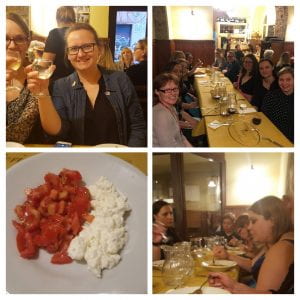
Wednesday 22 May
On the 3rd day of our week we were at the Faculty of Engineering which is literally next door to the Colosseum. I walked there from my hotel, which took around 30 minutes, and I got a magnificent view of the Colosseum from a local park on the route I took.
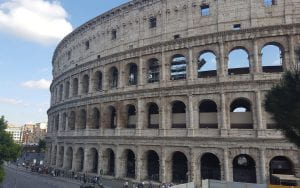
The Faculty building itself is a former convent and contains a central cloisters and well. Many of the rooms have decorative features including painted ceilings.
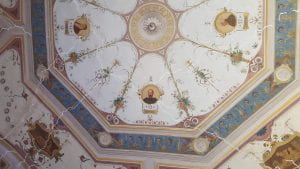
It seemed to be a day for a few graduations and we saw students and friends celebrating on the steps of the Engineering building. They wore crowns of laurel leaves, a tradition following the graduation (laurea) ceremony. The student receives a laurel wreath to wear for the rest of the day. This tradition originated at the University of Padua and has spread in the last two centuries to all Italian universities.
The theme for the day was ‘How many “literacies” are needed?’ and would be the day I did my presentation. I was a little worried by the equipment available compared to the previous days as there was a screen and a laptop. The first presentation of the day was by an Italian academic, Prof Miguel Angel Marzal from the Department of Library Science at Universidad Carlos III in Madrid. We had a quick translation after each section and, since returning, it is interesting to read his research including:
Martínez Pestaña, M.J. 2013, “Information policies: Development and strategies from EU programmes and their impact in Spain”, Revista General de Informacion y Documentacion, vol. 23, no. 1, pp. 9-25 (Available on Scopus)
Next, we heard from four of the delegates. Kaunas University of Technology in Lithuania has a number of priorities in 2019 for the Library including electronic and interactive learning resources, marketing strategies and integration of skills training. Tu Library in Estonia, is the biggest and oldest in the country. In contains 3.9 million items including manuscripts and rare books dating back to 1239. There is an impressive traditional library in Portugal at the University of Porto and the focus of the presentation was on new concepts in libraries. Digital content is managed by UPdigital, who design, make available, and manage the information infrastructures.
Finally it was my turn to do the presentation ‘Engaging students with referencing – challenging the dynamics with techno tools’ – I managed to navigate using the laptop with help from the facilitator. I had to do my introductory presentation first due to not being able to have time to present on the Monday. I finished my second presentation with a PollEverywhere competition entitled ‘Fed of Brexit – come and join me in the UK’ based on real questions from the British Citizenship tests. I had four prizes – marmite, marmalade, after-eights and Yorkshire tea. The presentation and competition were very well received.
There were three more speakers before lunch. From the University of Debrecen in Hungary, the talk was about teaching information literacy using a MOOC. At the Lithuanian University of Health Sciences, the focus was on the role of the library in research output management and lastly, there was a very interesting talk about the services for researchers at the Ecole Nationale des Chartres in Paris.
We had lunch at a café locally and then returned for the afternoon to hear our colleagues from Spain and Finland.
For Valencia University, the theme was Open Educational Resources (OER) and the Digital Competence Framework (DigComp 2.1). The last talk of the day was from Finland and centred around the new concept of Artificial Intelligence in libraries and the experiences with Iris.ai.
After the close of session we were free to choose where we wanted to go. I visited the church next to the Faculty building – San Pietro in Vincoli (Saint Peter in Chains) which is a Roman Catholic titular church and minor basilica, best known for being the home of Michelangelo’s statue of Moses, part of the tomb of Pope Julius II.
It has an altar with a crystal and gilded metal urn-reliquary containing the Chains of Saint Peter. It was a gift from the titular cardinal, Nicola Parracciani Clarelli in 1856 and was designed by Andrea Busiri.
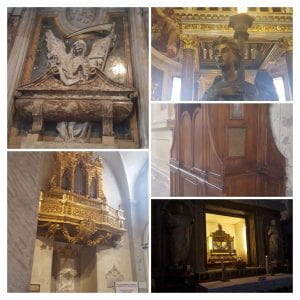
After visiting the church, we had an amble in the local area which has some artisan shops and small businesses. We also had another look at the Colosseum before I then made my way back to the hotel and later met up with my French colleague at the Termini station (where I think I spotted Dustin Hoffman, who I believe was filming in Rome) to get the metro to the Trastevere area so we could have dinner. Since the end of the Roman Republic the quarter was the centre of the Jewish community. It maintains character due to the cobbled streets and ancient houses and in the evening it is a thriving district with restaurants. We walked by the Circus Maximus which was an ancient Roman chariot-racing stadium and mass entertainment venue in Rome and crossed the river Tiber which is the third longest river in Italy. According to legend, Rome was founded in 753 BC on its’ banks.
Thursday 23 May
I enjoyed an hour-long walk to reach our venue for the final day of my stay. Passing the Collosseum again, I also stumbled upon the Forum of Augustus and the Temple of Mars Ultor.
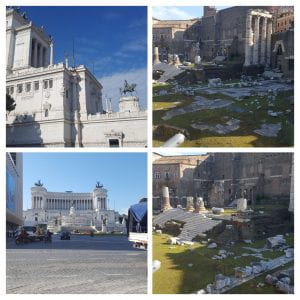
The Temple of Mars Ultor stands in the Forum of Augustus in Rome and was built to commemorate Augustus’ victory in 42 BCE at the Battle of Philippi over the assassins of Julius Caesar. The building became the place for important military decisions and a site of several state ceremonies with a military connotation.
Then I walked by the imposing The Vittorio Emanuele II Monument in Piazza Venezia also dubbed ‘the wedding cake’ built between 1885 – 1925 to honour Victor Emmanuel, the first king of a unified Italy.
The Faculty of Architecture is the largest in Italy and was the first to be founded in the country in 1921. We visited the Library in the Villa Borghese building. The Bibliotecha centrale della Facolta di Architettura has some major digital projects.
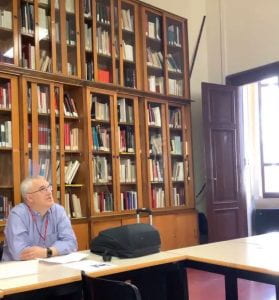
The day’s theme was ‘Academic libraries e-resources management’ and the presentations began with representatives from Sapienza. Firstly, there was information about Sapienza digital and e-resources management and about IRIS (Institutional Research Information System) which part of an Italian consortia initiative. The new system is a collaboration of several Italian universities and makes it easy to collect and manage data on research activities and outputs.
We then heard from Utrecht University about copyright and open science. In the Library, they train young researchers to help get them started with open access publishing. Our colleague from Portugal talked about the Portuguese Consortium of Electronic Resources – B-ON. The Biblioteca do Conhecimento Online – b-on (Online Knowledge Library makes unlimited and permanent access available, within the research and HE institutions, to full-texs from over 16,750 scientific international publications from 16 publishers, through subscriptions negotiated on a national basis with these publishers.
It was time for a break for a coffee in the relatively new ‘Literary Café’ in the same building. In addition to enjoying a coffee at the typically Italian coffee bar, you can enjoy some architectural drawings and models on display.
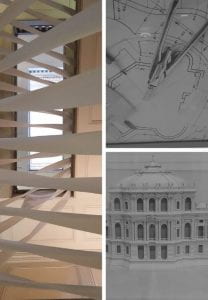
After coffee, we returned for two more presentations from Charles University in Prague and the University of Thessaly in Greece. Our colleague from the Czech Republic had been accompanied throughout the week by her ‘ice-breaker’ side-kick ‘Mr Bird’ and he featured in many photos through the week. He is a very well-travelled bird originally from Ikea. She gave an overview of Charles University as it is now in relation to e-resources and the importance of communicating to users of the Library. She finished with a thank you for the last four days and a goodbye from Mr Bird.
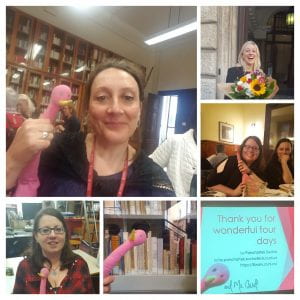
Lastly, we learned about the HEAL-Link Consortium and library e-resource discovery at the University of Thessaly.
My week of library related activities was over but we still had an afternoon of sightseeing and visits so after lunch and after collecting euros to buy a bunch of flowers for our host Agnese, we made our way locally to visit the Angelica Library and see a couple of Caravaggio masterpieces.
The Biblioteca Angelica owes its name to the Augustinian Bishop Angelo Rocca (1546-1620), an erudite writer and a keen collector of rare editions. He was in charge of the Vatican Printing House during the pontificate of Pope Sixtus V. Bishop Angelo Rocca entrusted his collection of some 20,000 volumes to the friars at the convent of St. Augustine in Rome at the end of the sixteenth century.
The library was closed for renovation in 1748 and was finally re-opened to the public in 1786 when the handwritten catalogue of all the printed books had been complete.
The current works of restoration and reorganisation have allowed the Institute to increase its book deposit and to offer new services to its patrons.
It really is an amazing place and very fitting for my final afternoon.
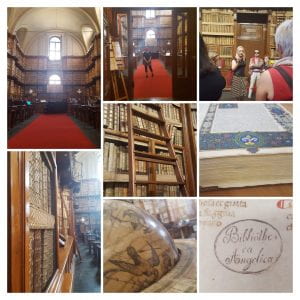
If that wasn’t enough, we then went and had a look at a couple of Caravaggio paintings in local churches.
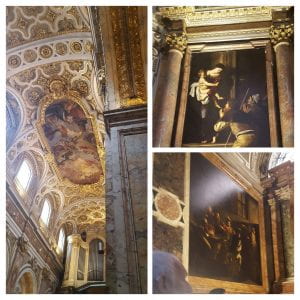
After leaving the church, I decided to spend the rest of the afternoon on my own, so I said my goodbyes to everyone. I actually felt quite emotional as it had been such an amazing week.
I went to the Pantheon and then visited the cat sanctuary nearby. Roman cats have always found shelter amongst the ancient ruins in the city. Torre Argentina is home to 150 cats, sheltered amongst the oldest temples in Rome (400-300 BC). Seven days a week volunteers, feed, clean and look after them. I didn’t see any stray cats on the streets and this is due to the 1000s being rescued each year, treated for illness and neutered then new homes found.
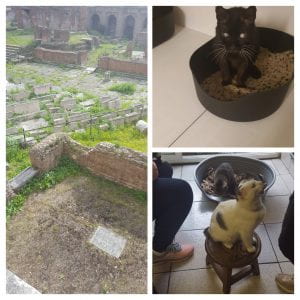
To raise funds, cats can be adopted at a distance and the volunteers also sell hand-made goods to raise funds. I bought a cat apron to remind me of my visit.
After wandering around locally for a little while and eating again at the restaurant I had found earlier in the week near the Trevi fountain, I made my way back to the hotel weary and ready for an early night.
The next morning I was up and ready to catch the local tram along to the station. This was an experience in itself as I was hardly able to get on it as it was very overcrowded. I then got the bus to the airport (which broke down on the way and a replacement bus picked us up). After a pleasant flight and a detour to Covent Garden, I made it back home. I would highly recommend the Erasmus opportunity to anyone considering it. I would definitely do it again.

